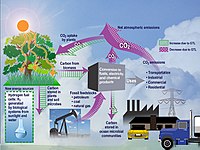
Photo from wikipedia
In order to explore the spatiotemporal evolution of land use function and its driving factors in China, taking both sides of the Hu Line as an example, we used Exploratory… Click to show full abstract
In order to explore the spatiotemporal evolution of land use function and its driving factors in China, taking both sides of the Hu Line as an example, we used Exploratory Spatial Data Analysis and Geographically Weighted Regression methods to reveal dynamic evolution law, spatial characteristics and influencing factors of the “Production-Living-Ecology” functions of 288 prefecture-level cities on both sides of the Hu Line. The results show that: (1) In the temporal dimension, the coordination of “Production-Living-Ecology” functions of land use in China has been improved, and the Hu Line can be roughly used as the boundary of China’s territorial space use. (2) In the spatial dimension, there is a significant positive spatial correlation between “Production-Living-Ecology” functions of land use in China, and the coordination gap between “Production-Living-Ecology” functions of land use on both sides of the Hu Line is gradually narrowing. (3) In terms of influencing mechanism, the coordination of “Production-Living-Ecology” functions is mainly driven by internal factors and is supplemented by external ones. The influence pattern of most driving factors is consistent with the layout characteristics of “strong east and weak west” of the Hu Line.
Journal Title: International Journal of Environmental Research and Public Health
Year Published: 2022
Link to full text (if available)
Share on Social Media: Sign Up to like & get
recommendations!